Neurocomputing 166 (2015) 282–293
Contents lists available at ScienceDirect
Neurocomputing
journal homepage: www.elsevier.com/locate/neucom
Semi-supervised deep extreme learning machine for Wi-Fi
based localization
Yang Gu a,b,c, Yiqiang Chen a,b,n, Junfa Liu a,b, Xinlong Jiang a,b,c
a Institute of Computing Technology, Chinese Academy of Sciences, Beijing, China
b Beijing Key Laboratory of Mobile Computing and Pervasive Device, Beijing, China
c University of Chinese Academy of Sciences, Beijing, China
a r t i c l e i n f o
a b s t r a c t
Article history:
Received 12 September 2014
Received in revised form
29 March 2015
Accepted 2 April 2015
Communicated by: G.-B. Huang
Available online 23 April 2015
Keywords:
Wi-Fi indoor localization
Semi-supervised learning
Deep learning
Extreme Learning Machine (ELM)
Along with the proliferation of mobile devices and wireless signal coverage, indoor localization based on
Wi-Fi gets great popularity. Fingerprint based method is the mainstream approach for Wi-Fi indoor
localization, for it can achieve high localization performance as long as labeled data are sufficient.
However, the number of labeled data is always limited due to the high cost of data acquisition.
Nowadays, crowd sourcing becomes an effective approach to gather large number of data; meanwhile,
most of them are unlabeled. Therefore, it is worth studying the use of unlabeled data to improve
localization performance. To achieve this goal, a novel algorithm Semi-supervised Deep Extreme
Learning Machine (SDELM) is proposed, which takes the advantages of semi-supervised learning, Deep
Leaning (DL), and Extreme Learning Machine (ELM), so that the localization performance can be
improved both in the feature extraction procedure and in the classifier. The experimental results in real
indoor environments show that the proposed SDELM not only outperforms other compared methods but
also reduces the calibration effort with the help of unlabeled data.
& 2015 Elsevier B.V. All rights reserved.
1.
Introduction
Wireless localization based on Wi-Fi is quite popular, especially
in indoor environment [1–3], for it does not need deploying any
extra infrastructure. What is more, the widespread Access Points
(APs) and smart mobile devices facilitate the development of Wi-Fi
based indoor localization. To implement indoor localization, tradi-
tionally, labeled data are required. In Wi-Fi localization field, labeled
data means both data and their corresponding locations (coordi-
nates/classes) are known; unlabeled data means only data are
available, and whose corresponding locations are unknown. Gen-
erally, there are mainly two types of Wi-Fi localization methods:
propagation based method and fingerprint based method. The
propagation based method takes the advantage of the nonlinear
fading characteristics of wireless signal to set up a propagation
model [1]. This kind of method can be easily implemented; however,
the localization performance is not good enough for it is difficult to
set up an accurate propagation model in a complex and dynamic
indoor environment. Compared with propagation based method,
fingerprint based localization method is widely adopted. “Finger-
prints” are features obtained by feature extraction methods, and
used to represent the corresponding locations; “localization” means
n Corresponding author at: Institute of Computing Technology, Chinese Academy
of Sciences, Beijing, China.
http://dx.doi.org/10.1016/j.neucom.2015.04.011
0925-2312/& 2015 Elsevier B.V. All rights reserved.
adopting pattern recognition method to estimate the location.
Theoretically, the more the labeled data are, the better the localiza-
tion performance will be. However, the calibration procedure (which
is also known as the acquisition of labeled data) is always at the cost
of time, man-hour and money, which leads to the limited number of
labeled data. According to [4], “calibration procedures are applied in
a great number of proposed location techniques and are considered
to be not practical or a considerable barrier to wider adoption of
such methods”. As reported [5], Ekahau [6], a commercial real-time
localization system, spent $10,000 just to collect labeled data in a
large office building, which clearly verifies the high cost of obtaining
labeled data.
In contrast to the acquisition of labeled data, the collection of
unlabeled data can be carried out easily; especially when crowd
sourcing is adopted. Crowd Sourcing [7,8] is a distributed model to
solve problems through an open way with different participants. For
indoor localization, crowd sourcing (data collection) means gathering
data from heterogeneous devices [9], and most of the data are
unlabeled. In order to use unlabeled data, works based on manifold
learning and semi-supervised learning were proposed. These works
indeed improved localization performance with unlabeled data;
however, they paid less attention to the problem caused by crowd
sourcing.
After data have been collected for localization system, feature
extraction becomes an important step. Though Received Signal
Strength (RSS) of Wi-Fi signal has real physical meaning and can
�
Y. Gu et al. / Neurocomputing 166 (2015) 282–293
283
be directly used as feature; the highly dynamic indoor environment
and heterogeneous devices lead to severe fluctuation of wireless
signal, which makes this kind of direct feature less representative.
Traditional indoor localization methods mainly selected features
manually or extracted features by shallow networks, which cannot
reflect Wi-Fi characteristics in complex environment well. However,
a machine learning method, Deep Learning (DL) has been famous
worldwide since 2006 [10]. DL learns high level features and
distributed data structure, which can represent original data better
than shallow feature. Though DL outperforms traditional neural
networks, its training time consumption is high. While, Extreme
Learning Machine (ELM) proposed in the same period as DL, is
popular for fast learning speed, which can make up the time-
consuming shortage of DL.
Considering the analysis above, we put forward a novel localiza-
tion method, Semi-supervised Deep Extreme Learning Machine
(SDELM) to improve the localization performance with unlabeled
data. The contribution of this work is:
1) Utilize unlabeled data to get discriminative features and better
classification ability;
2) Propose semi-supervised embedding for deep leaning network;
3) Adopt modified ELM to improve the learning speed of SDELM.
The rest of this paper is organized as follows: Section II shows the
related works in Wi-Fi localization field. Section III introduces the
proposed SDELM in detail. Section IV evaluates the performance of
SDELM in real wireless indoor environments. And Section V con-
cludes the work.
2. Related works
The mainstream approach of Wi-Fi based indoor localization,
fingerprint based method [2,3], consists of two phases: off-line
training phase and online locating phase. At training phase, features
are extracted according to a certain rule, so that the relationship
between features and their corresponding locations can be estab-
lished, which forms a “radio map”; at online locating phase, features
of unknown location are extracted with the same rule, and pattern
recognition methods are used to find the best matched locations on
the “radio map”, then the final location can be estimated by those
matched locations. Two parts in fingerprint based method: feature
extraction and pattern recognition (classifier) involve unlabeled/
labeled data, which can affect the overall localization performance.
For these two parts, there are many related works.
For feature extraction, it is well-known that Wi-Fi signal is fickle:
the unpredictable movement of people, the status of door (open/
closed), the change of temperature and humidity, the placement of
objects, the type of device [11] et al., which all lead to the fluctuation
of Wi-Fi signal. Hence, feature extraction work of Wi-Fi can greatly
affect the final localization performance. Up till now, most fingerprint
methods extract shallow level information from labeled data as Wi-Fi
feature. Mean value method is the commonest feature extraction
method [12–15], which collected multiple RSS vectors at the same
location, and averaged those vectors to form the feature. Even though
RSS changes unpredictably, the mean value can, from the statistical
view, reduce the unstableness of RSS. Further than mean value
method, Gaussian model was put forward based on the assumption
that RSS at the same location satisfied Gaussian distribution. [16]
utilized Gaussian process to eliminate the side-effect caused by small
probability RSS and outliers, and averaged high probability RSS
vectors to get feature. Except for statistical feature extraction meth-
ods, unsupervised machine learning method is also adopted. [17]
used Principal Component Analysis (PCA) to extract Wi-Fi feature; the
principal components of multi-dimension wireless signal not only
offered new feature but also reduced the effect of noise. AP selection
methods were also put forward, for AP is the emission source of Wi-Fi
signal. [18] picked out k APs with the strongest RSS at each location as
feature. [19] proposed InfoGain criterion to evaluate the merit of each
AP in terms of power and selected the highest ones to form feature.
Other than common feature extraction approaches, special methods
were also presented to solve specific problems. To overcome the
variance caused by different devices, [20] came up with a hyperbolic
method, utilizing signal strength ratio instead of absolute signal
strength to form feature. And to mitigate the distortion caused by
human body, [21] proposed an ellipse signal attenuation model to
generate an orientation-independent fingerprint database.
Though there were many works proposed to extract features for
Wi-Fi based localization, seldom utilized unlabeled data. Besides,
most of them were at shallow level, which cannot represent the Wi-
Fi characteristics in complex indoor environment well.
For fingerprint based localization methods, pattern recognition
methods (classifiers) are used to estimate the final
localization
result, and most of the traditional methods are supervised [1].
However, considering the fact that labeled data are limited and
unlabeled data are adequate, manifold learning and semi-supervised
learning methods were widely adopted. Pan [22] proposed a
manifold learning method to calculated users’ location and APs’
location.
It first adopted SVD based method with labeled and
unlabeled data to calculate relative locations (which is a dimension
reduction process), then used manifold assumption to get the
absolute locations with the assist of labeled data. Pulkkinen [23]
used Isomap method to reduce the feature space to a low dimension
manifold space; then transformed the manifold space to location
space to implement localization. By carefully selected key points to
represent fingerprints, this method can calibrate an entire radio map
based on a small fraction of labeled data; and according to the
experiment, the mean localization error was 2.0 m when there were
66 testing points. Zhang [24] presented LocMR method based on
manifold regularization, which learnt the mapping from signal space
to location space; the novelty of the work is that time span
constraint is brought into the calculation of Laplacian matrix, so
that the manifold in time domain can be maintained. In order to
utilize unlabeled data, Lin [25] applied spectral decomposition of
Laplacian matrix to get data representation in eigenvectors space,
then added labels to unlabeled data by aligning labeled data. The
result showed that only with small proportion of labeled data like
20%, the localization accuracy can reach to 75%. A semi-supervised
localization method, Semi-supervised Extreme Learning Machine
(SELM) [26], was put forward based on ELM, which brought graph
Laplacian constraint to ELM, so that the sparsely calibrated localiza-
tion system can perform well with fast learning speed.
Though there are plenty of existing manifold and semi-
supervised works which can improve the localization performance
with unlabeled data; however, most of them are based on shallow
features and do not take crowd sourcing into consideration.
Therefore, considering the practical localization problems such
as feature extraction and unlabeled data from crowd sourcing, we
put forward SDELM method on the basis of semi-supervised
learning, deep learning and ELM, so that the overall localization
performance can be improved.
3. Methodology–Semi-supervised deep extreme learning
machine
Graph based semi-supervised learning is embedded to deep
learning structure to get discriminative feature and better classifica-
tion boundary. To guarantee the learning speed, semi-supervised
learning is evolved from ELM. Hence, in this section, we firstly
�
284
Y. Gu et al. / Neurocomputing 166 (2015) 282–293
goal of AE based DL is to minimize reconstruct error, making
hW;b Xk
� Xk, which equals to minimize the loss function:
#
�
� �
ð
J W; b
Þ ¼ min
W;b
"
"
1
N
XN
XN
i ¼ 1
�
�
i ¼ 1
1
2
¼ min
W;b
1
N
briefly introduce graph based semi-supervised learning, deep lean-
ing, and ELM; then elaborate the proposed SDELM in detail.
3.1. A. Graph based Semi-supervised Learning
Semi-supervised learning is between unsupervised learning and
supervised learning, which utilizes a small amount of labeled data
and a large amount of unlabeled to train a model. There are three
assumptions for semi-supervised learning [27]: smoothness assump-
tion, cluster assumption and manifold assumption. The smoothness
assumption implies that if two points are close in a high-density
region, their corresponding outputs should also be close. The cluster
assumption is used to find the boundary of each cluster, for “if points
are in the same cluster, they are likely to be in the same class”, and
cluster assumption can be seen as a special case of smooth assump-
tion. The manifold assumption is used to avoid “the curse of
dimensionality”. And semi-supervised learning should satisfy at least
one of the above assumptions.
Semi-supervised learning usually adopts graph based methods,
data points (both labeled and unlabeled data) are the vertexes of the
graph, and the goal of graph based methods can be expressed as:
!
�
V f xið
Þ; yi
�þλA‖f ‖2 þλI
Z
M
arg min
f
1
l
f xð Þ‖∇Mf xð Þ‖2dp xð Þ
ð1Þ
Where M is the manifold that data lie in, and λA, λI are the
parameters control the smoothness in the ambient and intrinsic
spaces, l is the number of samples. Among all the graph based
methods, Laplacian graph is mostly adopted, which makes (1) be
approximately expressed as:
�
V f xið
Þ; yi
�þλA‖f ‖2 þλIf T Lf
!
ð2Þ
arg min
f
1
l
Xl
i ¼ 1
Xl
i ¼ 1
Where L is the Laplacian matrix.
3.2. B. Deep Learning
Deep learning is a branch of neural networks, which simulates
the multi-layer cognition of human brain to obtain high level
features and distributed data structure. The basic idea of DL is firstly
using unsupervised learning methods to pre-train the network layer
by layer; then making the training output of lower level as the input
for the upper layer; and finally adopting supervised methods to fine-
tune the parameters of the whole network [28,29].
DL with different building blocks has been applied to many
fields [30–34], and here we mainly introduce DL built up with
Auto Encoder (AE) [35]. Assuming there is a DL network with M
hidden layers, which is illustrated in Fig. 1. (Each node in the lower
layer is connected to all the nodes in the upper layer, here to make
the figure concise, only some connections are shown). Lk is the
neuron number of the kth hidden layer.
Each layer of AE consists of encoding and decoding procedure.
Assuming Xk represents the input data, W k1 is the encoding weight,
bk1 is the encoding bias; W k2 and bk2 are the corresponding
decoding weight and bias. The encoding and decoding steps follow
the rules [35]:
Encoding : Xk ¼ fðzkÞ
zkþ 1 ¼ W k1Xk þbk1
ð3Þ
Decoding : XM þ k ¼ fðzM þ kÞ
zM þ kþ 1 ¼ W M � k
ð
Þ2
Þ2XM þ kþb M � k
ð4Þ
The encoding step means encoding each layer in forward order,
and decoding step means decoding stack of AE in reverse order
(The encoding and decoding weight and bias can be different). The
ð
J W; b; Xk
�
‖f W; b; Xk
#
�
�
�Xk‖2
ð5Þ
With pre-training process, better initial value of encoding
(decoding) weight and bias can be calculated from (5) . And based
on these parameters, the final optimal parameters can be obtained
by the fine-tuning process. Encoding output of the final layer is the
high level feature to represent original input data.
3.3. C. Extreme Learning Machine
Extreme Learning Machine (ELM) is a supervised learning
method proposed by Huang et al. [36–38]. The random generation
of input weight and bias of ELM [39] is the essential difference
from other conventional neural networks, which leads to the fast
Þ, where
learning speed. Given N arbitrary distinct samples Xi; T i
Aℜn is the input feature and n is the input
Xi ¼ Xi1; Xi2; …Xin
Aℜm is the output vector repre-
½
dimension, T i ¼ T i1; T i2; …T im
sents the class and m is the output dimension. Neural network
with L hidden neurons can be illustrated in Fig. 2.
ð
½
The output of this network can be expressed as:
i ¼ 1
ð6Þ
βiGðwi; bi; XiÞ; wi Aℜn; bi Aℜ; βi Aℜm
ðXiÞ ¼
f L
½
is the weight vector connecting the ith hidden
wi ¼ wi1; wi2; :::; win
�
neuron and input neurons, and bi is the threshold of the ith hidden
neuron, Gðwi; bi; XiÞ is the output of the ith hidden neurons.
βi ¼ βi1; βi2; ⋯; βim
neuron and the output neurons.
If the activation function of
hidden neuron is g Xð Þ, then the output of the ith hidden neuron
can be calculated as (7):
Gðwi; bi; XiÞ ¼ gðwi UXi þbiÞ; wi Aℜn; bi Aℜ
�T is the weight vector connecting the ith hidden
ð7Þ
XL
...
...
...
...
...
Output data
Hidden layer LM
Hidden layer L1
Input data
Fig. 1. Deep network with M hidden layers.
w
w
n L
Lm
L
Fig. 2. SLFN with L hidden neurons.
�
Y. Gu et al. / Neurocomputing 166 (2015) 282–293
285
The above two equations can be summarized as:
Hβ ¼ T
2
Where
64
H ¼
2
664
Gðw1; b1; X1Þ ⋯ GðwL
3
Gðw1; b1; XNÞ ⋯ GðwL
775
βT
1
⋮
βT
L
; bL
⋮
; bL
T T
1
⋮
T T
N
; XNÞ
; X1Þ
2
664
3
775
3
75
T ¼
β ¼
N�L
⋱
⋮
;
;
N�m
L�m
ð8Þ
ð9Þ
The goal of ELM is to obtain β ¼ argmin
‖Hβ�T‖, so that the
error between real output and expected output can be minimized.
The solution of ELM is :
β ¼ H†T ¼ HTH
�� 1
ð10Þ
�
HT
β
Where “†” is the Moore–Penrose generalized inverse of matrix.
The above result is the minimum norm least-squares solution of
eq. (8), which guarantees the minimum error and the least norm
at the same time.
3.4. D. Proposed Semi-Supervised Deep Extreme Learning Machine
for Wi-Fi
As claimed above,
indoor localization, the limited
number of labeled data is a practical problem. To solve it, we put
forward SDELM localization method, utilizing both labeled and
unlabeled data (crowd sourcing) to improve localization performance.
For SDELM, deep learning embedded with semi-supervised learning
is used to get high level abstract feature and better classification
ability; and ELM is used to enhance the learning speed.
The original goal of ELM is: Hβ ¼ T. Here, in order to study the
characteristics of both labeled data and unlabeled data as AE does,
the goal is changed to (11):
ð11Þ
Hβ ¼ X
Þ ðXi ¼ ½Xi1; Xi2:::Xin
Where X represents N1 labeled data Xi; T i
Aℜn; T i ¼ ½T i1; T i2:::T imAℜmÞ and N2 unlabeled data Xj ðXj ¼
½Xj1; Xj2:::XjnAℜnÞ), N1 þN2 ¼ N. In order to ensure the smooth-
ness of proposed method, which is “Points which are close to each
other are more likely to share a label”, a smoothness constraint is
‖f ‖2 (f ¼ Hβ and C1 is the
brought in to the target, which is C1
2
balance parameter). Besides, in order to avoid over fitting and
guarantee the generalization ability, ℓ2;1 norm regularization
C2=2‖β‖2 is added to the target (C2 is also a balance parameter).
ð
Fig. 3. Framework of deep feature extraction.
ð13Þ
ð14Þ
Therefore the loss function for deep feature extraction becomes:
l1 ¼ min
ð12Þ
According to ELM, f ¼ Hβ is put into (12); then the loss function
‖f �X‖2 þC1
2
‖f ‖2 þC2
2
‖β‖2
1
2
f
becomes:
1
l1 ¼ min
2
β
‖Hβ�X‖2 þC1
2
‖Hβ‖2 þC2
2
‖β‖2
∂l1
∂β
ð
ÞT HþC1 Hβð
The derivative of β with respect to l1 is:
¼ Hβ�X
�
When ∂l1=∂β ¼ 0, we get the solution of β, which is:
ÞT HþC2βT
�� 1
ð
ð
HT X
ÞUI1
ÞHþC2I2
β ¼ HT C1 þ1
ð15Þ
I1 AℜN�N and I2 AℜL�L are identity matrixes (L is the number
of hidden neuron). For the kth layer of the deep feature learning,
�
the output weight is:
βk ¼ HT
ÞUI1
ÞHkþC2I2
�� 1
k C1 þ1
ð
ð
kXk� 1
HT
� �T
ð16Þ
We adopt this modified ELM as building block, and use βk
as
weight matrix to get each layer's output [40]. If the activation
function is g xð Þ, then the output of the kth layer becomes:
Xk ¼ g
�
� �T
UXk� 1
ð17Þ
�
βk
The framework of this deep feature extraction is illustrated in
Fig. 3.
To summarize, the deep feature extraction has three steps: 1) for
each layer, calculate output matrix based on (16); 2) get the output of
each hidden layer with its corresponding output weight matrix; 3)
make the lower layer output as the input for next upper layer.
After the feature extraction process, the final high level features
are put into the classifier. In order to guarantee the generalization
ability of classifier, ℓ2;1 norm regularization is brought in, and the
goal becomes:
β
min
‖β‖2
‖f �T‖2 þC
2
1
2
C is a weight penalty. Besides ℓ2;1 norm constraint, Laplacian
graph regularization is also added to (18) to generate a precise
classification boundary, which makes the final goal of classifier:
ð19Þ
‖β‖2 þλTr f T Lf
ð18Þ
min
�
�
1
2
‖f �T‖2 þC
2
β
Where λ is a constraint penalty, Tr is the trace of matrix, and L is
Laplacian matrix calculated as:
L ¼ D�W
D is a diagonal matrix given by Dii ¼ PN1 þ N2
ð20Þ
i ¼ 1 W ij, and W is the
edge weight matrix, which is usually processed with Gaussian
kernel:
ð21Þ
!
W ij ¼ exp �‖Xi�Xj‖2
2σ2
With f ¼ Hβ,
becomes:
l2 ¼ min
the goal of
the semi-supervised classifier
�
�
β
Þ
ÞT L Hβð
‖JHβ�T‖2 þC‖β‖2 þλTr Hβð
ð22Þ
In (22), J AℜN�N is the indication matrix to distinguish labeled data
iaj.
from unlabeled data, and J i; i
For N training data, T Aℜm�N is the corresponding extended label
matrix, m is the number of class. If one labeled data belongs to class j,
then for the label vector, the jth value is set to be 1, and the rest m�1
Þ
i ¼ 1; 2; :::; N1;
Þ ¼ 1;
Þ ¼ 0;
ð
J i; j
ð
ð
�
286
Y. Gu et al. / Neurocomputing 166 (2015) 282–293
values become �1; the label vectors for unlabeled data are all set to
be 0. In order to get the solution of this optimization problem, we get
the derivative of β with respect to l2 in (22), which is:
∂l2
∂β
¼ JHβ�T
ð23Þ
The solution of β satisfies the condition that ∂l2=∂β ¼ 0, which
h
ÞT JHþCβT þλ Hβð
ÞT LH
ð
i� 1
ð24Þ
is:
β ¼ C UIþHT JþλL
ð
ÞH
HT JT
Eqs. (16) and (24) are the solutions of weight matrix, which
construct the structure of SDELM. Constraint parameters in those
equations and the depth of deep feature learning affect the overall
performance of SDELM; hence we need to tune these parameters.
There are mainly four kinds of parameters in SDELM needed to be
tuned, which are weight C1, C2 in deep learning procedure, and
weight λ, C in classifier. Usually, cross validation is used to adjust
these four parameters. However if the parameters are tuned
simultaneously, the time complexity will be Oðn4Þ, which is time-
consuming. Therefore, in order to make the adjustment easier and
less costly, we adopt hierarchical adjustment mechanism to tune
the parameters, which is similar to sparse coding [34] (For sparse
coding, it firstly optimized sparse coefficients with fixed bases, then
tuned the bases with fixed coefficients). The parameters are split
into two levels according to their
level
the first
function;
parameters are the parameters in the classifier, and the second
level parameters are the parameters in deep learning. Firstly, we
assign empirical values to these parameters, and then tune the first
level's parameters. After optimizing parameters in the first level, we
adjust the parameters in the second level. With this hierarchical
adjustment mechanism, the time complexity can be decreased.
Here, we show an example to make the scheme clear: for depth di,
we adjust the parameters in the classifier at first, then tune the
parameters in the deep learning procedure with locally optimized C
and λ. When all these four parameters are optimized, the final
localization result rdi is obtained. Then we increase the depth by 1,
which makes diþ 1 ¼ diþ1. Again, we adopt the same scheme to
tune the parameters and get its corresponding result rdi þ 1. When
for the first time, the final depth becomes dep ¼ di,
rdi þ 1
otherwise diþ 1 ¼ diþ1. This greedy scheme is used to determine
the depth of the network. With optimized parameters and depth,
the SDELM model can be set up.
Þ,
To sum up, given N1 labeled wireless training data Xi; T i
Aℜm, and N2
where Xi ¼ Xi1; Xi2; :::; Xin
unlabeled training data Xj Aℜn; n is the number of collected AP
and m is the number of class. SDELM algorithm can be summar-
ized as:
Aℜn,T i ¼ T i1; T i2; …; T im
ordi
ð
½
½
1) Prepare all the training data,
2) Assign initial depth value di ¼ 0;
unlabeled data, and normalize them into [0, 1];
including labeled data and
Fig.4. Model generation of SDELM.
�
Y. Gu et al. / Neurocomputing 166 (2015) 282–293
287
3) Determine activation function g xð Þ, number of hidden neurons
hidnumk for deep learning and activation function f xð Þ, num-
ber of hidden neurons hidnumc for classifier;
4) Assign initial values for C1, C2 in deep learning and the
constrain parameter C, λ in classifier;
�
5) Randomly assign the weight matrix W k and bias matrix bk for
�
the kth layer;
6) Calculate the kth hidden layer output by equation Hk ¼
g W k UXk� 1 þbk
�
�� 1
layer output matrix by (16): βk ¼
ÞUI1
;
7) Calculate the kth
ÞHk þC2I2
k C1 þ1
ð
ð
HT
kXk� 1;
HT
input for the upper layer;
8) Calculate the output of the kth layer by (17), and make it as the
9) Transform the labels of N1 labeled data to Nnmð
10) Calculate the classifier output weight by (24);
11) Put the last layer output of deep learning into the semi-
Þ matrix;
supervised classifier to get the result;
12) Utilize hierarchical mechanism to adjust parameters C1, C2, C,
and λ, then go through steps 4) to 11) to get the final result for
the corresponding depth;
13) Make diþ 1 ¼ diþ1, and go through 4) to 12).
14) If rdi þ 1
4rdi , go through 4) to 13), else the model is set up.
The model generation framework of proposed SDELM is illu-
strated in Fig. 4.
4. Performance Evaluation
In this section, performance of proposed SDELM will be validated
from four aspects: feature representation, localization accuracy, time
consumption and man-hour cost in real indoor environments.
4.1. A. Office environment
Firstly, localization performance of SDELM is validated in a typical
office environment. It is a 15 mn10 m area on the 8th floor of a
research building with 24 different locations, whose layout is shown
in Fig. 5. Circle points are the locations where labeled data were
collected. The reason to choose this environment as test bed is that it
is highly dynamic, full of people movement and other changing
elements, which can show the complex characteristics of Wi-Fi
signal in indoor environment. In this environment, we collected
5695 items of data in one month; 500 of them were randomly
chosen as testing data and the rest became training data. The
experimental configuration is as follows: DELL PC with 32 bit
Operation System, 2.00 G RAM, Intel Core2 CPU, and Matlab R2009b.
To show the statistical characteristics of RSS, another 500 data
were collected at the same location, and Fig. 6 illustrates the
distribution of RSS for the same AP. Obviously, even though the
signal was collected for the same AP at the same location by the
Fig. 5. Indoor location environment.
0.35
0.3
0.25
0.2
0.15
0.1
0.05
y
t
i
l
i
b
a
b
o
r
P
0
-85
-80
-75
-70
-65
-60
RSS(dbm)
Fig. 6. RSS distribution for the same AP over a time period.
same device, RSS still can fluctuate from -83 dbm to -60 dbm, which
makes the difference bigger than 20dbm. Therefore, if the discri-
minability of feature is not good enough, the location will be
wrongly estimated, which degenerates the localization performance.
Hence, a good feature extraction method is necessary, and we
propose SDELM.
4.1.1. a) Model generation
To verify the performance of SDELM, an effective model should
be set up at first. Here, we randomly choose 500 labeled data and
3000 unlabeled data from training data set; the number of hidden
neuron for each layer is 300. Initial value for constraint parameter C1
is set to be 0.2, and C2 is set to be 0.01. The parameters for semi-
supervised classifier are: “sig” activation function,C ¼ 0:001, λ ¼ 0:3,
1000 hidden neurons, σ for Gaussian kernel is 0.5, and the number
of Laplacian graph neighbor is 5.
When the depth is 0, model achieves its best accuracy 30.2% with
C ¼ 0:0005 and λ ¼ 0. We record this result, and increase the depth
to 1. When dep ¼ 1, firstly, parameters in the classifier are tuned, and
the corresponding result is given in Fig. 7.
In Fig. 7, when C ¼ 0:01 and λ ¼ 0:3(Lambda), the model gets its
locally optimal result. Then based on the value of C and λ, we
adjust the parameters in deep feature extraction procedure, and
the result is illustrated in Fig. 8.
From the experiment, when dep ¼ 1, C1 ¼ 0:1, C2 ¼ 0:0, C ¼ 0:01
and λ ¼ 0:3, the network get its best result, which is 31.2%
(classification accuracy). Apparently, this result is better than that
when dep ¼ 0. Hence, we increase the depth of network to dep ¼ 2,
and tune the parameters to get the result, which is shown in Fig. 9.
When dep ¼ 2, the combination of parameters C1 ¼ 0:2, C2 ¼ 0:01,
C ¼ 0:001 and λ ¼ 0:3 leads to the optimal localization accuracy
34.4%, which is better than that when dep ¼ 1. Therefore, the depth
is increased to 3, and related result with different parameters is
illustrated in Fig. 10. And the combination of parameters C1 ¼ 0:2,
C2 ¼ 0:01, C ¼ 0:001 and λ ¼ 0:4 leads to the best classification
accuracy, 32%, which is not better than that when dep ¼ 2. Hence,
the model is generated with two layers of deep learning, one layer of
classifier, and C1 ¼ 0:2, C2 ¼ 0:01, C ¼ 0:001, λ ¼ 0:3.
4.1.2. b) Feature Extraction
The discriminability of SDELM's feature is mainly compared
with that of shallow feature “mean value”. Different features are
put into the same Nearest Neighbor (NN) classifier. Since NN is the
most basic classifier which does not need to tune any parameters,
and the stronger the discriminability of the feature is, the better
the localization performance will be.
�
288
Y. Gu et al. / Neurocomputing 166 (2015) 282–293
We test the feature extraction ability of the generated model
with 500 labeled data, and the number of unlabeled data changes
as: 0, 500, 1000, 2000, and 3000. The performance with different
features is shown in Fig. 11.
Fig. 11 consists of six bars, the first one “shallow” is the
performance without deep learning, just adopting shallow features
(mean value), and the rest five bars are the performance of deep
features with different number of unlabeled data (0, 500, 1000,
2000, and 3000). The localization accuracy also represents the
classification accuracy. From the first bar to the last bar, the accuracy
changes as: 18.6%, 19.9%, 20.5%, 21.6%, 22.8%, and 23.0% respectively.
We find that even using the most naïve NN classifier, from the first
two bars, localization performance of deep feature still can be
improved by 1.3% with the same training data. And with the number
of unlabeled data increase, classification accuracy shows a rising
trend. When there are 3000 unlabeled data, localization accuracy
improves 4.4% than that of shallow feature. The performance here
verifies that the extracted deep feature of SDELM can improved the
discriminability of fingerprints, and unlabeled data can have positive
effects on feature extraction.
y
c
a
r
u
c
c
A
n
o
i
t
a
z
i
l
a
c
o
L
0.35
0.3
0.25
0.2
0.15
0.1
0.05
0
01e-0050.0001 0.001 0.01 0.03 0.05
C
0.1
0.3
0.5
1
0
1
0.9
0.8
0.7
0.6
Lambda
0.5
0.4
0.3
0.2
0.1
Fig. 7. Localization accuracy when dep¼1 with different combination of classifier
parameters.
y
c
a
r
u
c
c
A
n
o
i
t
a
z
i
l
a
c
o
L
0.35
0.3
0.25
0.2
0.15
0.1
0.05
0
0 0.1 0.2 0.3 0.4 0.5 0.6 0.7 0.8 0.9
C1
0.00010.0010.01 0.04 0.07 0.1 0.3 0.5 0.7 1
Fig. 8. Localization accuracy when dep¼1 with optimized classifier parameters
and different deep learning parameters.
C 2
0
1
y
c
a
r
u
c
c
A
n
o
i
t
a
z
i
l
a
c
o
L
0.35
0.3
0.25
0.2
0.15
0.1
0.05
0
01e-0050.0001 0.001 0.01 0.03 0.05
C
0.1
0.3
0.5
1
0
1
0.9
0.8
0.5
0.4
0.7
0.6
Lambda
0.3
0.2
0.1
4.1.3. c) Localization Performance
After verifying the feature extraction ability of SDELM, we testify
its overall localization performance. Firstly, localization performance
of SDELM is compared with existing shallow indoor localization
methods: RADAR [1], Support Vector Machine (SVM) [41], and SELM
[26]. We use ‘libsvm’ [42] software package to implement SVM, and
adopt cross-validation method to find the best parameters c and g in
range ½2
� 24; 224 with footstep 20:5. Finally c¼20:5 and g¼8. Para-
meters for SELM are: 250 hidden neurons, 5 neighbors for Laplacian
graph, σ ¼ 0:5 for Gaussian kernel, and λ ¼ 0:5. Parameters for SDELM
are the same as those in Section a. Error distance criterion is adopted
to measure the localization performance. Specifically, if the distance
between estimated location LE and real (excepted) location LR (usually
location information is a two dimension coordinate or a label, and one
label is related to one coordinate) is smaller than pre-defined error
distance r, which is ‖LE �LR‖rr, then the localization is considered
to be correct, and vice versa. Localization accuracy is the percentage
that the number of correct localization accounts for the number of
total localization, which is acc ¼ numright=numall. The localization
performance of different algorithms is illustrated in Fig. 12.
In Fig. 12,
it is obvious, with the localization error distance
increase, localization accuracy for each algorithm improves. Especially,
SELM has better classification accuracy than RADAR and SVM, for
SELM utilizes unlabeled data to achieve more precise classification
plane; SVM utilizes support vectors to mitigate the fluctuation of
wireless signal, therefore its performance is better than the baseline
RADAR. SDELM achieves the relatively best localization performance,
for the extracted high level feature and semi-supervised classifier
improve the localization ability.
Besides the comparison with shallow localization methods, SDELM
is also compared with deep learning methods, such as SAE (Stacked
auto encoder) [35], DBN (Deep belief network) [10], and ML-ELM
(Multi-layer Extreme Learning Machine) [40]. The parameters for
SDELM are still the same as above with structure 24-300-300-1000-
24; and the network structure for SAE, DBN and ML-ELM are: 24-300-
y
c
a
r
u
c
c
A
n
o
i
t
a
z
i
l
a
c
o
L
0.35
0.3
0.25
0.2
0.15
0.1
0.05
0
0 0.1 0.2 0.3 0.4 0.5 0.6 0.7 0.8 0.9 1
C1
0.01 0.02 0.03 0.04 0.05 0.06 0.07 0.08 0.09 0.1
C 2
0
Fig. 9. Localization accuracy when dep¼2 with different parameters. (a). Different combination of classifier's parameters (b). Different combination of deep learning's
parameters.
�
Y. Gu et al. / Neurocomputing 166 (2015) 282–293
289
y
c
a
r
u
c
c
A
n
o
i
t
a
z
i
l
a
c
o
L
0.35
0.3
0.25
0.2
0.15
0.1
0.05
0
01e-0050.00010.001 0.01 0.03 0.05 0.1 0.3 0.5
C
1
0
1
0.9
0.8
0.7
Lambda
0.6
0.5
0.4
0.3
0.2
0.1
y
c
a
r
u
c
c
A
n
o
i
t
a
z
i
l
a
c
o
L
0.35
0.3
0.25
0.2
0.15
0.1
0.05
0
0
0.1
0.2
0.3
0.4
0.5
C1
0.6
0.7
0.01 0.02 0.03 0.04 0.05 0.06 0.07 0.08 0.09 0.1
C 2
0.8
0.9
1
0
Fig. 10. Localization accuracy when dep¼3 with different parameters. (a). Different combination of classifier's parameters (b). Different combination of deep learning's
parameters.
y
c
a
r
u
c
c
A
n
o
i
t
a
z
i
l
a
c
o
L
0.25
0.2
0.15
0.1
0.05
0
Shallow D-0
D-500 D-1000 D-2000 D-3000
Fig. 11. Localization performance with the same 500 labeled data and different
number of unlabeled data.
y
c
a
r
u
c
c
A
n
o
i
t
a
z
i
l
a
c
o
L
1
0.9
0.8
0.7
0.6
0.5
0.4
0.3
0.2
0.1
0
RADAR
SVM
SELM
SDELM
1
2
3
4
5
6
7
8
9
10
Error Distance(m)
Fig. 12. Localization performance for different localization methods.
24; 24-200-24; 24-500-2000-24 respectively. The localization perfor-
mance is shown is Table 1.
Form Table 1, we can see that except SDELM, other deep learning
methods have similar localization performance, which is better than
Table 1
Localization performance for deep learning methods.
SAE
DBN
ML-ELM
SDELM
Accuracy (%)
Training time (s)
29.80
110.3083
31.20
93.3978
29.60
36.8318
34.40
63.9448
shallow localization methods. And SDELM slightly outperforms the
other three methods, because it not only extracts high level features
as deep learning methods do, but also utilizes semi-supervised
classifier to improve the classification ability.
Besides the localization performance, we also compare the
learning speed for different deep learning methods. Apparently,
SDELM has less amount of training time than SAE and DBN, for
SDELM neither has iterative optimization for the pre-training step,
nor needs the fine-tuning procedure. In contrast to ML-ELM, SDELM
spends more time, as the calculation of Laplacian matrix is time-
consuming. However, considering the trade-off between accuracy
and time consumption, SDELM is a reasonable choice to solve the
indoor localization problems.
4.1.4. d) Man-hour Cost
The goal of SDELM is to utilize unlabeled data to improve
localization performance, so that the man-hour of gathering labeled
data can be reduced. Hence, how much man-hour of calibration can
be saved is tested in this part. In Fig. 12, in order to achieve
approximately 34% localization accuracy (34.4%) when the error
distance is 1 m, 500 labeled data and 3000 unlabeled data are
needed. Here, we only use labeled data and change the number of
them to get the same localization performance, and the result is
shown in Fig. 13. Parameters of SDELM are the same as those in
Section c.
In Fig. 13, when error distance is 1 m, the localization accuracy
changes as: 24.4%, 28.8%, 32.1%, 33.3%, and 35.4% with different
number of labeled data. The result indicates that 1500 or 2000
labeled data are needed to achieve approximately 34% (33.3% or
35.4%) localization accuracy when the error distance is 1 m. How-
ever, when unlabeled data are used to assist localization, from
Fig. 12, we find that only 500 labeled data are required to achieve
the same localization performance (34.4%), which means with the
help of unlabeled data, man-hour can be saved to achieve the same
result.
�
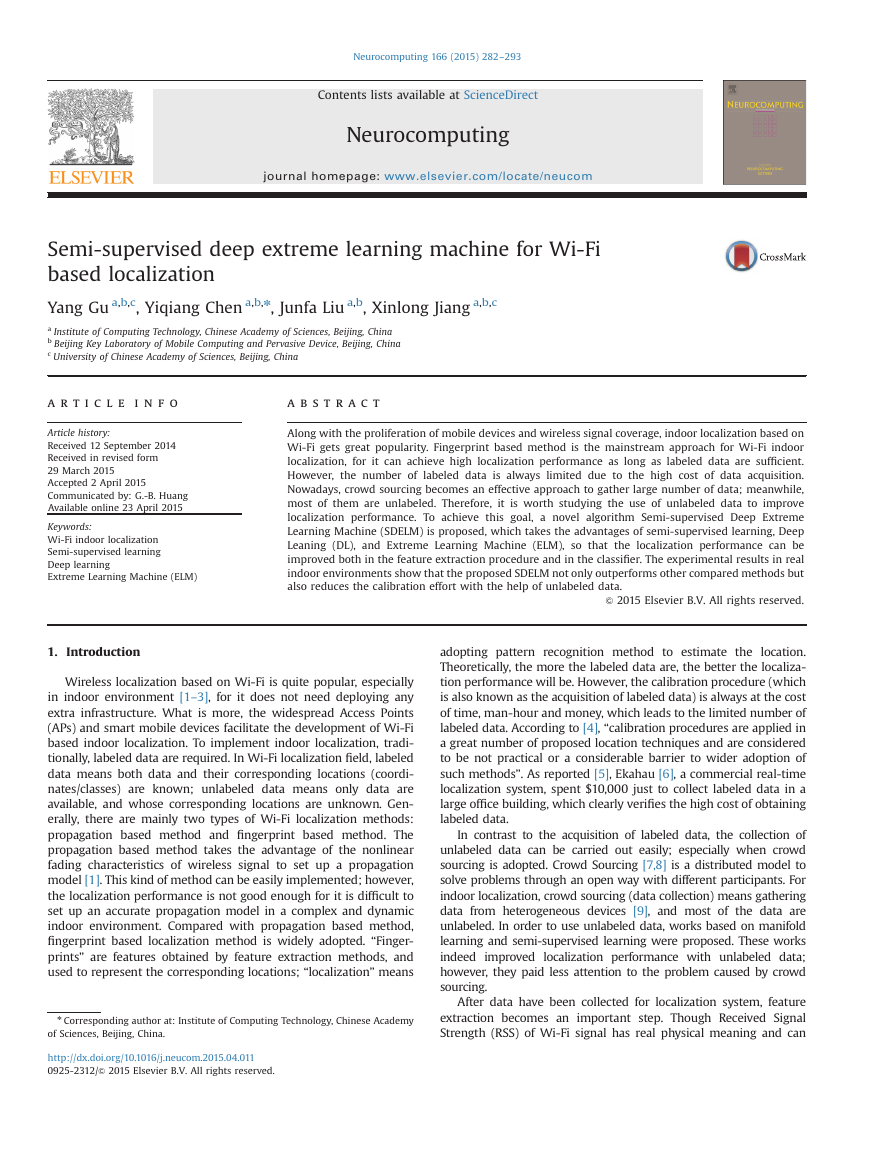
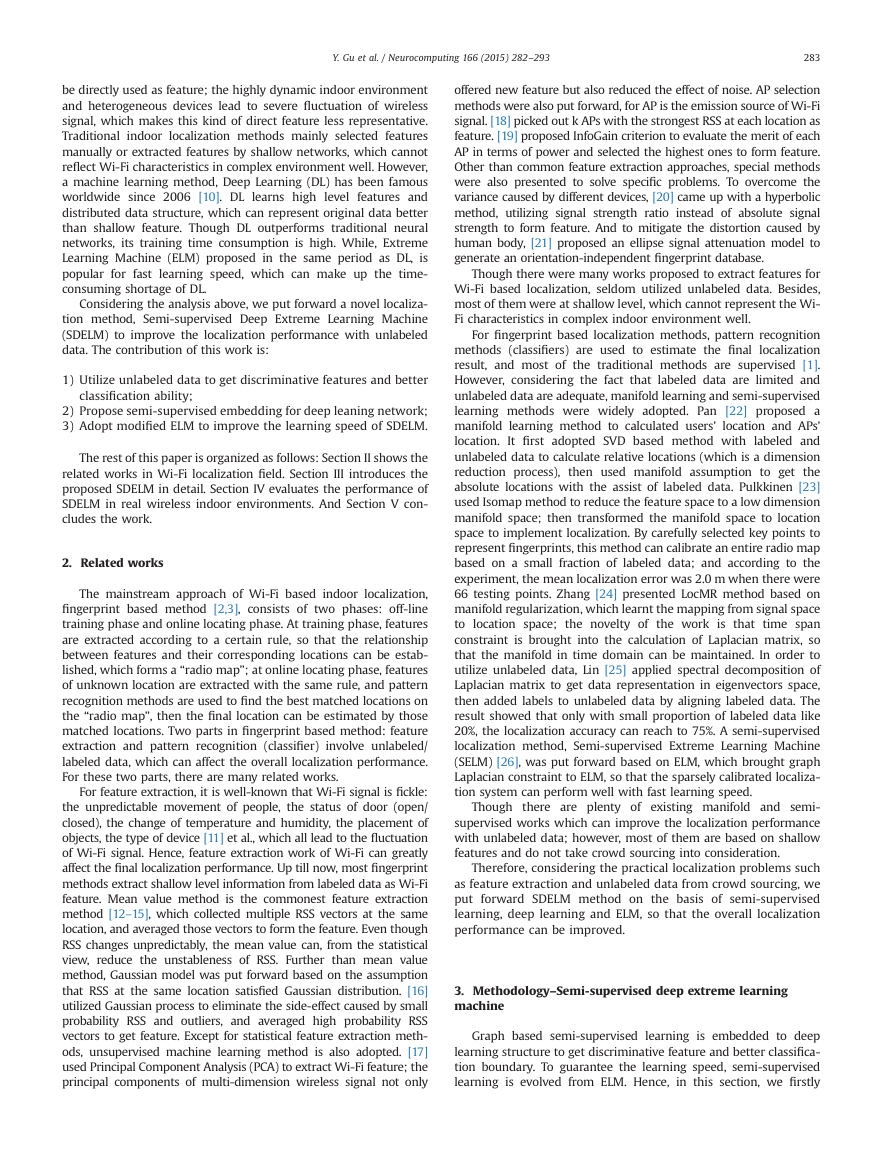
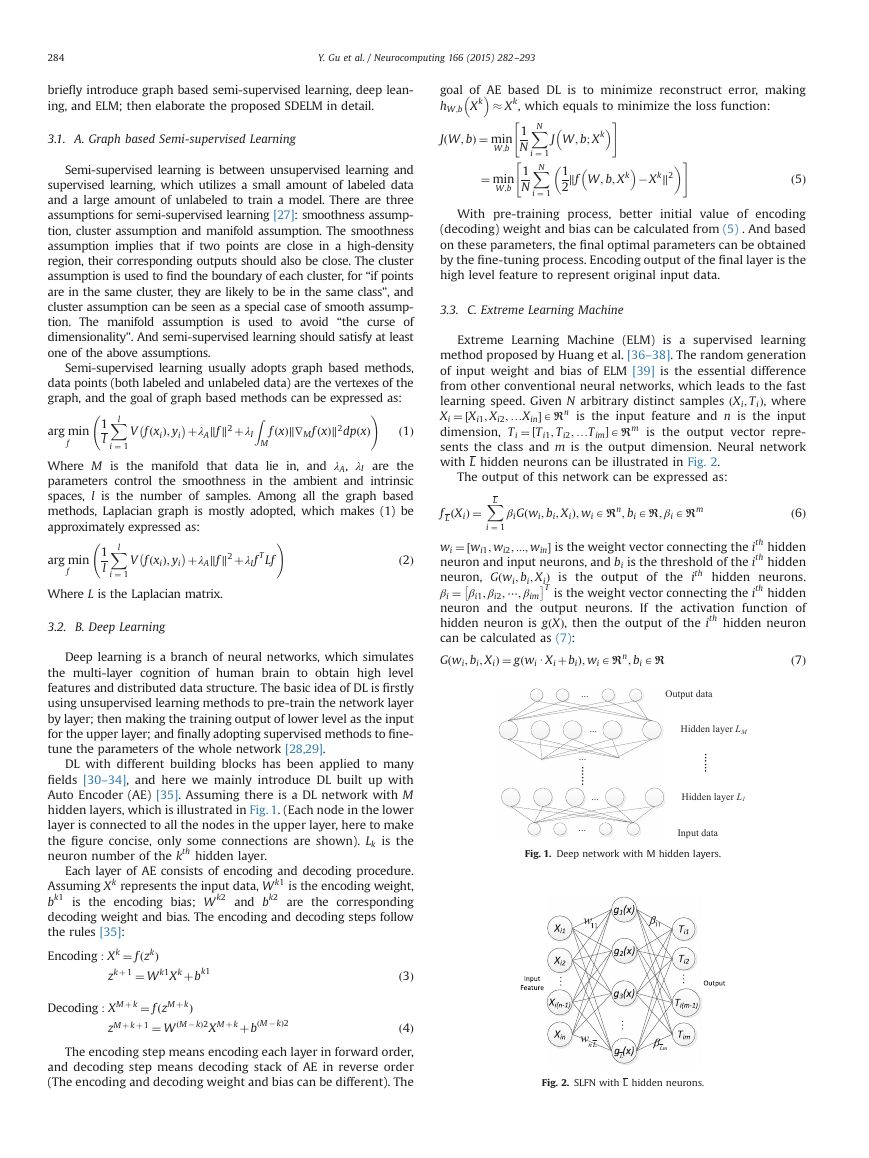
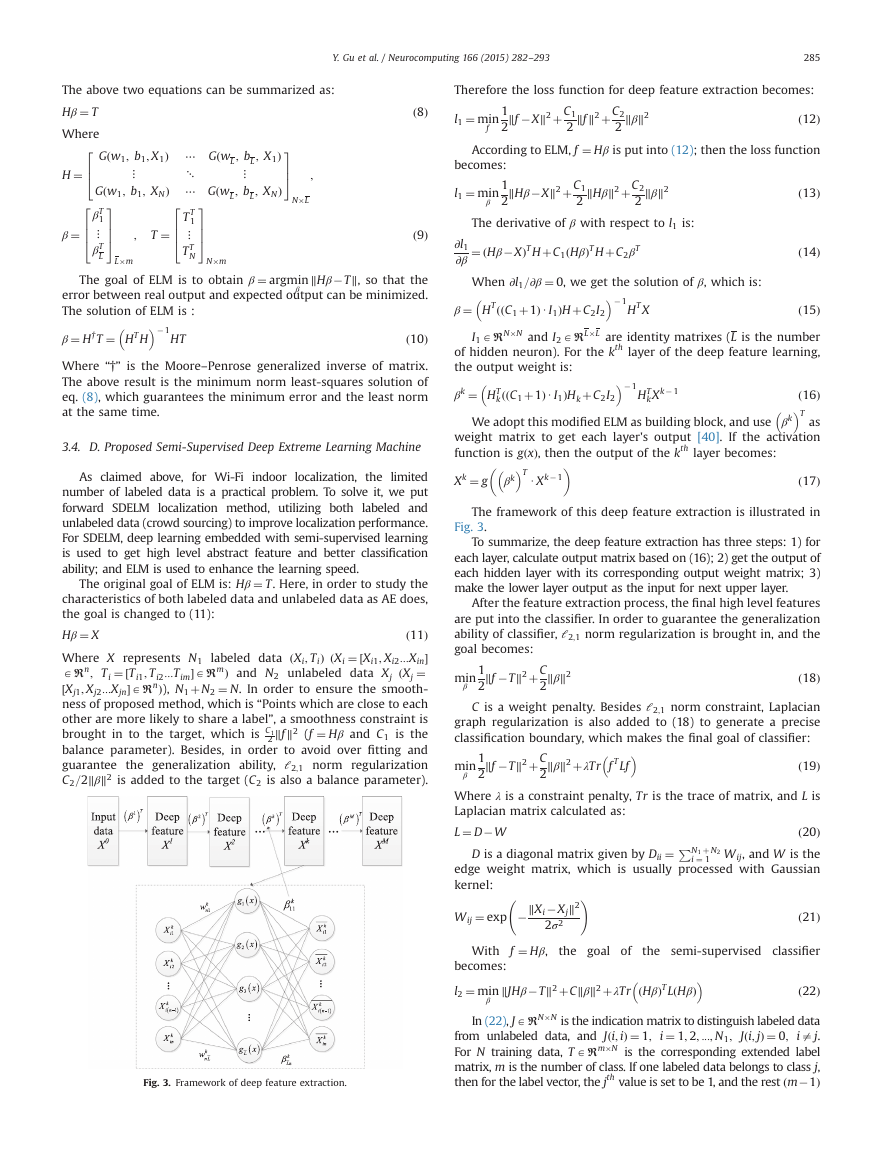
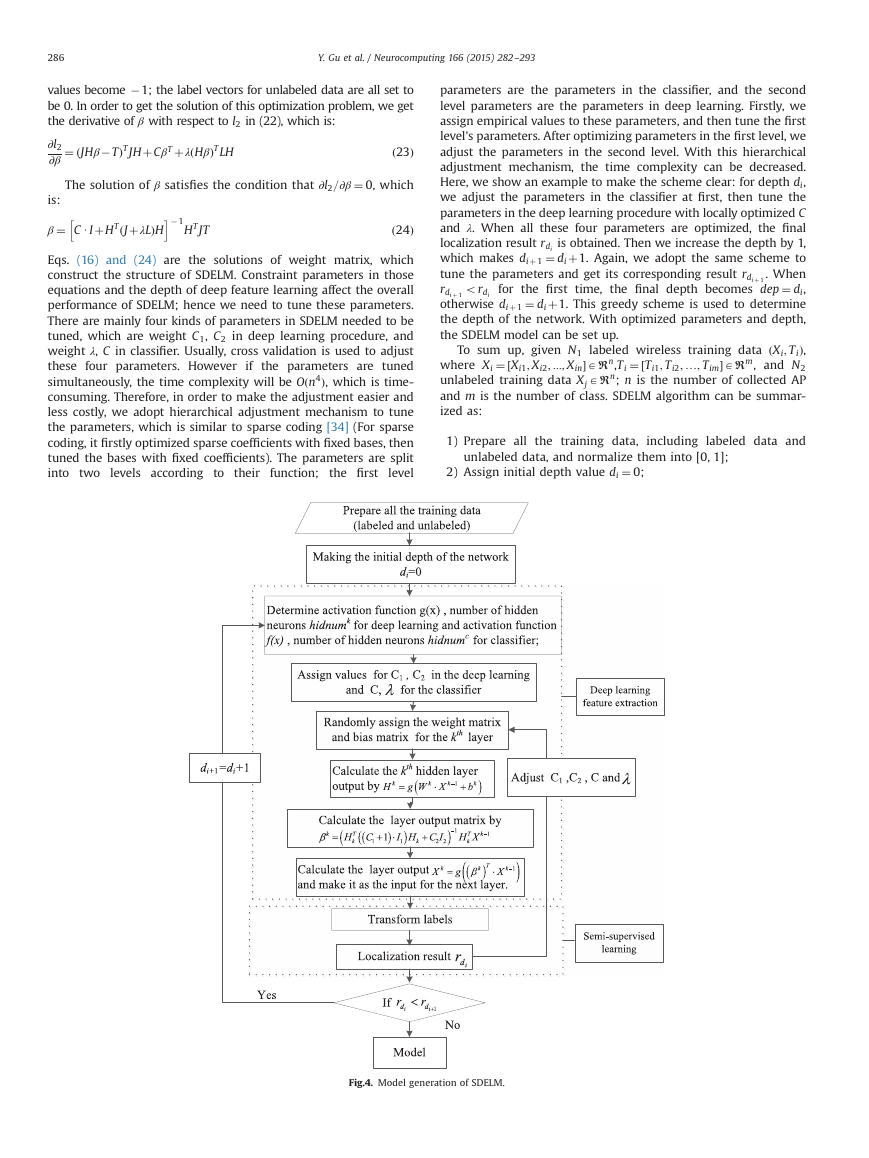
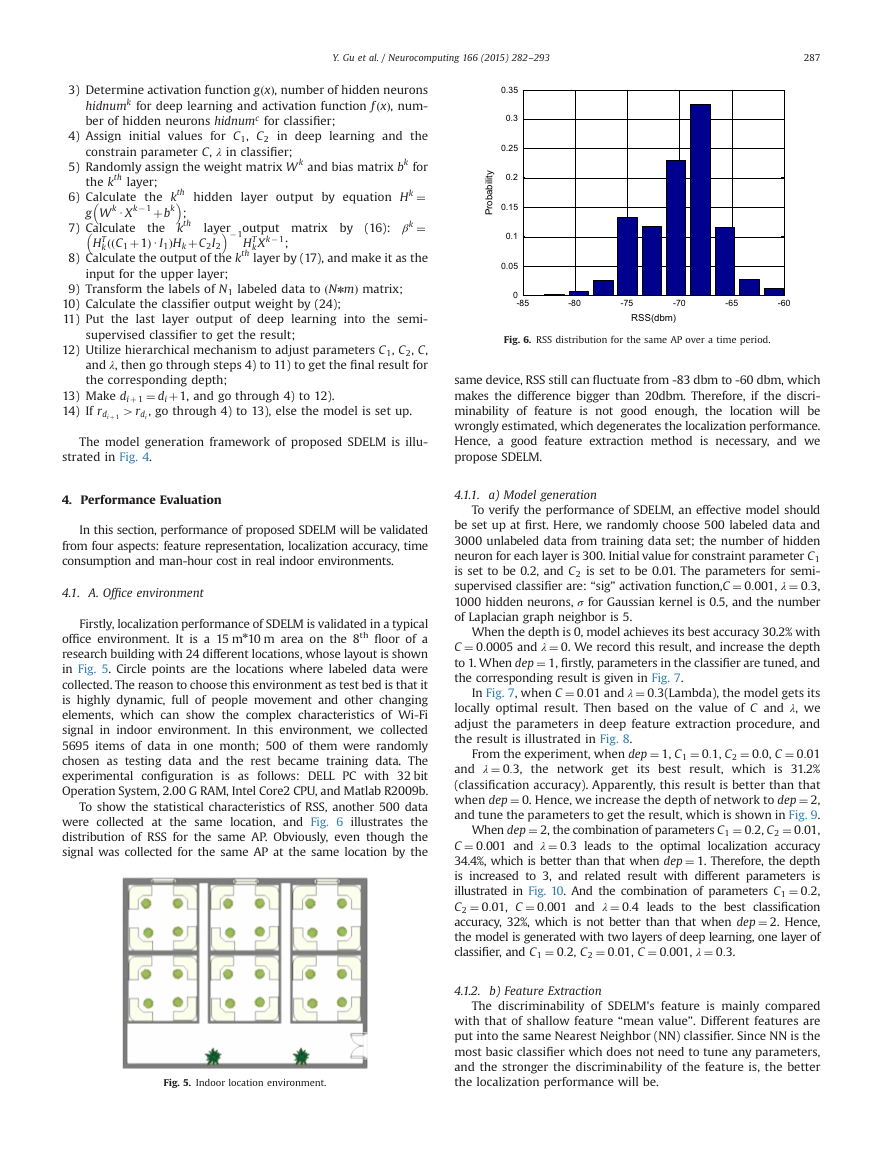
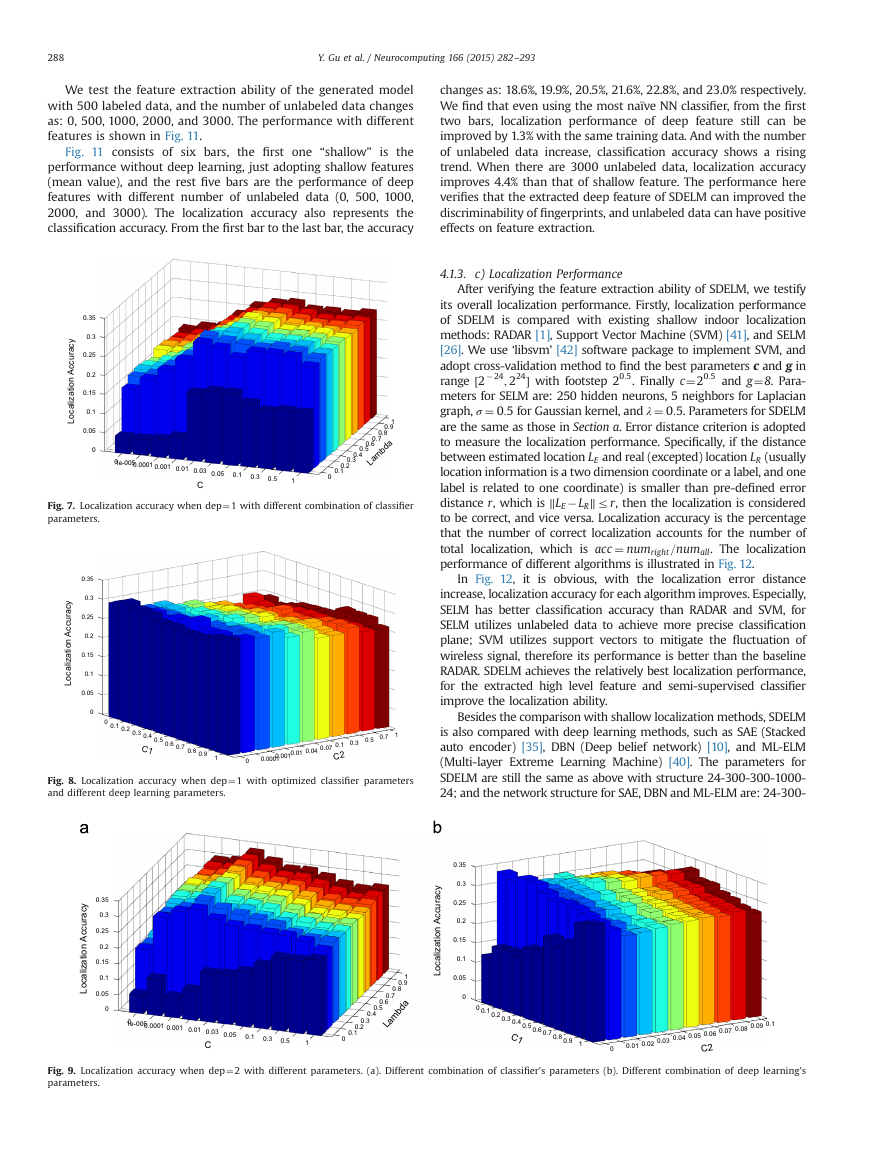









 2023年江西萍乡中考道德与法治真题及答案.doc
2023年江西萍乡中考道德与法治真题及答案.doc 2012年重庆南川中考生物真题及答案.doc
2012年重庆南川中考生物真题及答案.doc 2013年江西师范大学地理学综合及文艺理论基础考研真题.doc
2013年江西师范大学地理学综合及文艺理论基础考研真题.doc 2020年四川甘孜小升初语文真题及答案I卷.doc
2020年四川甘孜小升初语文真题及答案I卷.doc 2020年注册岩土工程师专业基础考试真题及答案.doc
2020年注册岩土工程师专业基础考试真题及答案.doc 2023-2024学年福建省厦门市九年级上学期数学月考试题及答案.doc
2023-2024学年福建省厦门市九年级上学期数学月考试题及答案.doc 2021-2022学年辽宁省沈阳市大东区九年级上学期语文期末试题及答案.doc
2021-2022学年辽宁省沈阳市大东区九年级上学期语文期末试题及答案.doc 2022-2023学年北京东城区初三第一学期物理期末试卷及答案.doc
2022-2023学年北京东城区初三第一学期物理期末试卷及答案.doc 2018上半年江西教师资格初中地理学科知识与教学能力真题及答案.doc
2018上半年江西教师资格初中地理学科知识与教学能力真题及答案.doc 2012年河北国家公务员申论考试真题及答案-省级.doc
2012年河北国家公务员申论考试真题及答案-省级.doc 2020-2021学年江苏省扬州市江都区邵樊片九年级上学期数学第一次质量检测试题及答案.doc
2020-2021学年江苏省扬州市江都区邵樊片九年级上学期数学第一次质量检测试题及答案.doc 2022下半年黑龙江教师资格证中学综合素质真题及答案.doc
2022下半年黑龙江教师资格证中学综合素质真题及答案.doc